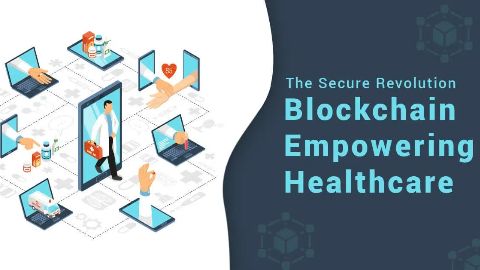
Blockchain Technology in Healthcare Data Management: Enhancing Security, Interoperability and Patient Empowerment
The healthcare industry is undergoing a digital transformation, this data explosion has exposed critical challenges in security, interoperability, and patient control. Blockchain technology has emerged as a promising solution to these challenges.

This article explores the applications, benefits, and challenges of blockchain in healthcare data management, drawing on recent advancements and real-world implementations.
1. How Blockchain Works in Healthcare
Blockchain is a distributed digital ledger that records transactions securely and transparently across a network of computers. In healthcare, each transaction can represent an interaction with patient health data. Key features include:
-
Decentralization: Eliminates single points of failure by distributing data across multiple nodes.
-
Immutability: Once data is added to the blockchain, it cannot be altered without consensus, ensuring integrity.
-
Smart Contracts: Self-executing contracts automate processes like data access consent and insurance claims.
-
Cryptographic Security: Data is encrypted and stored offline or hashed on-chain, balancing privacy and transparency.
2. Key Applications of Blockchain in Healthcare
2.1. Electronic Health Records (EHRs)
Blockchain enables secure, patient-controlled EHR management. Patients can grant or revoke access to specific providers, ensuring privacy and reducing data silos. For example, MedRec allows secure sharing of EHRs between patients and providers. Similarly, projects like the cross-border data verification platform between Shenzhen and Hong Kong use blockchain to share electronic medical records and reports seamlessly.
2.2. Drug Supply Chain Transparency
Blockchain tracks pharmaceuticals from manufacture to delivery, preventing counterfeit drugs. IBM's Food Trust and MediLedger projects use blockchain to ensure authenticity and reduce fraud.
2.3. Clinical Trials and Research
Blockchain timestamps protocols, consent forms, and data entries, making clinical trial data immutable and auditable. This enhances transparency and trust in research outcomes. For instance, PharmaLedger uses blockchain for clinical trial management and anti-counterfeiting measures.
2.4. Health Insurance and Billing
Smart contracts automate claims processing, reducing administrative costs and fraud. They enable real-time verification of transactions, streamlining insurance workflows.
2.5. Cross-Border Data Sharing
Blockchain facilitates secure cross-border health data exchange. The Shenzhen-Hong Kong cross-border data channel uses blockchain and privacy computing to transmit medical data compliantly, supporting telemedicine and international collaborations.
3. Data Security and Privacy Protection
Blockchain addresses critical security vulnerabilities in traditional centralized systems:
-
Encryption and Access Control: Techniques like elliptic curve encryption (ECC) and advanced encryption standards (AES) protect data confidentiality. Frameworks like ACHealthChain integrate IPFS for decentralized storage, storing only hashes on-chain to ensure integrity.
-
Privacy-Preserving Technologies: Zero-knowledge proofs and privacy computing enable data sharing without exposing raw data.
-
Auditability and Traceability: All transactions are logged on the blockchain, providing a tamper-proof audit trail for compliance and accountability.
4. Case Studies and Real-World Implementations
4.1. Estonia's National Health Record System
Estonia implements blockchain at a national level to secure health records, giving citizens real-time control over data access.
4.2. BurstIQ's Data Exchange Network
This U.S.-based company uses blockchain to enable personalized, compliant health data sharing for patients and providers.
4.3. Shenzhen-Hong Kong Cross-Border Data Verification Platform
This platform uses blockchain to generate unique "data fingerprints" for documents, allowing instant verification of medical records, credit reports, and academic credentials without transmitting raw data. It has facilitated over HKD 100 million in credit loans for mainland enterprises in Hong Kong.
4.4. ACHealthChain Framework
This blockchain-based framework, built on Hyperledger Fabric and IPFS, improves throughput and reduces latency compared to traditional systems. It uses sub-chains for policy management, EHR storage, diagnosis data, and auditing, enhancing scalability and security.
5. Challenges and Limitations
Despite its potential, blockchain faces several challenges:
-
Scalability: Throughput declines as nodes increase. Layer 2 solutions or hybrid chains are needed to handle large medical datasets.
-
Integration Complexity: Legacy systems and organizational barriers hinder adoption.
-
Regulatory Uncertainty: Legal frameworks for cross-border data sharing are still evolving.
-
Cost and Expertise: Initial setup requires significant investment in infrastructure and training.
6. Conclusion
The integration of blockchain with IoT, edge computing, and privacy-enhancing technologies like zero-knowledge proofs will enable real-time, secure health data sharing. Projects like the "Medical Data Infrastructure" initiative in China, which integrates IPv6 and data spaces, aim to build cross-border data ecosystems for medical collaboration. Standardization efforts will further support global data governance.
Blockchain technology offers a transformative approach to healthcare data management, enhancing security, interoperability, and patient empowerment. While challenges remain, thoughtful integration with existing systems and evolving regulatory frameworks will unlock its potential to create a more efficient, transparent, and patient-centric healthcare ecosystem.
You May Like
Blockchain: The Backbone of Next-Generation Digital Infrastructure
Blockchain technology has transitioned from a niche innovation to a transformative digital infrastructure underpinning various industries. At its core, blockchain is a decentralized, distributed ledger that records transactions immutably, reducing dependence on centralized entities.
Blockchain for Digital Identity Verification: A Paradigm Shift in Digital Trust
Blockchain technology, with its core tenets of decentralization, immutability, and cryptographic security, is emerging as a transformative solution for digital identity verification, promising to redefine the relationship between individuals and their digital identities.
Global Bitcoin Adoption and Holdings: A Country-by-Country Overview
Bitcoin, the leading cryptocurrency, has gained strong global foothold, with millions embracing it for diverse uses. Its adoption varies by country, influenced by population, tech infrastructure, and economy, reshaping global finance.
Bitcoin Surges Past $81,000 Amid "Trump Trade" and Growing Crypto Optimism
Bitcoin rose 6.7% over the weekend, with Ethereum up 8% and Cardano surging over 30%, on hopes of stronger Trump administration crypto support. Fueled by the "Trump Trade", Bitcoin has gained 35% post-Trump's win and 94% this year.